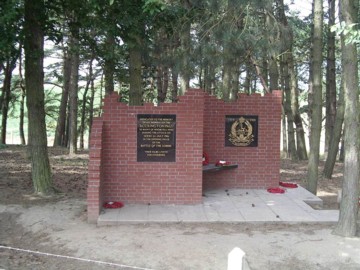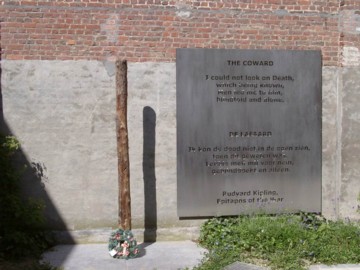WW1 Battlefield And Memorial Sites - Part 1

Accrington Pals Monument

Chorley Pals Monument
Being from Lancashire originally we also took poppies to the Accrington Pals Memorial, which is build of Accrington brick, the Chorley Pals Memorial and the Barnsley Pals in the Sheffield Memorial Park. Passing through the wooded park there are trenches, and bomb holes and at the bottom is the Railway Hollow Cemetery, which was a dressing station at the side of the railway, hence it’s name.
We saw the Lochnagar Crater, which was blown by the British tunnelling and placing huge charges under the Germans, and where in 1998 the body of George Nugent was found. There is now a small memorial denoting where he was found, on the far side of the crater.
Our final visit in the Somme was to the cemetery in Denain, again a special place to place a poppy for Don. This is a war graves cemetery set within the civilian cemetery, a beautifully kept place in a slightly neglected cemetery.
On the Sunday we travelled to Belgium. Our first visit was going to be “Plugstreet” Wood but, despite having SatNav, it eluded us so we decided to go to Tyne Cot Cemetery first. Here we spent a very quiet time thinking of Tony, because this was his favourite place and I am sure his spirit was there with us there.
Here we placed our own cross and poppy. I found this a very sad place because all the time on the path to the visitors’ centre they are playing a recording of the names and ages of the soldiers killed in action over the speaker system. After the visit to the visitors’ centre, we went into Passchendaele. In the town there is a statue of a witch and the weighing scales used to see if the alleged witches weighed more than a duck. Thank goodness we couldn’t find a duck, or they would have weighed me!
On to Ploegsteert (known to those who served there as “Plugstreet”) and we found it straight away. We obviously weren’t meant to find it the first time because, when we arrived at the British Memorial, they were just getting ready for a wreath laying ceremony and I am convinced we were meant to see that. The officer in charge came round and explained that every year the cadets in the Belgium army run from one end of Belgium to the other. It’s a “Run and Remember” in memory of the fallen and, in every town that they go through, they place wreaths at a memorial.

Passchendaele Cemetary

Shot at Dawn Post
We moved on to the wood itself, and a peaceful walk to visit the cemeteries in there. Last year when my daughter and son-in-law were in the wood, Claire kept getting a number flashing through her head, and then a name, she also had a loss of feeling in her arm. So, when they got back to Preston they went onto the War Graves website and found there was someone with that name and number. They determined where he was buried and on this trip she had to satisfy her curiosity and go in search of the grave at Lijssenthoek.
It came as no surprise to us that we found the grave and we laid a poppy for him. Here also is the grave of one of the few nurses who were killed in WW1. During the day we visited many graves and laid poppies at that of Captain Noel Chavasse, one of only three soldiers to be awarded the double VC. We later visited the Breton Memorial, sadly I found that this was somewhat neglected, bushes overgrown and untidy.
Our first visit of the next day was Poperinghe to see the “Shot at Dawn” cell and execution post, where deserters were shot at dawn. The awful thought is that those who were caught and kept in the cell could actually see the execution post in the courtyard from the cell window.
Ypres, or Ieper to the Flemings, is a very famous place in Flanders where, at the Menin gate every night at 8.00pm, the pompiers play the last post. This is a most moving experience, especially so on the night of our visit as there was a youth band from Tyneside playing some wonderful music including Abide With Me. Every night an old lady visits the ceremony, she has a seat which is brought across by one of the officials and she has attended every night to date. Again we had a job to do, place a poppy for one of Don’s relatives.
Our visit to Belgium also included Hill 62 (Sanctuary Wood) Museum, where there are hundreds of rare and very graphic three-dimensional glass slides of WW1 to be seen in the “1p in the slot” viewing boxes. The museum is not very well organised, but outside there remain original trenches with their corrugated tin sides; you can walk where the soldiers walked and see the trees still showing bullet holes and the bomb craters.
The one thing that I noticed about all the cemeteries and memorials that we visited, was the silence, and peaceful atmosphere that was in them all; it was as if no birds sang, no one spoke in anything other than a whisper. Everyone respected the brave men that were buried and remembered there.
Since our return, two of the places we visited have been on Who Do You Think You Are on TV. Daniel O’Donnell has an ancestor buried in Denain Cemetery and someone else, with whom I wasn’t familiar, went to Hill 62.
Dorothy Norcross